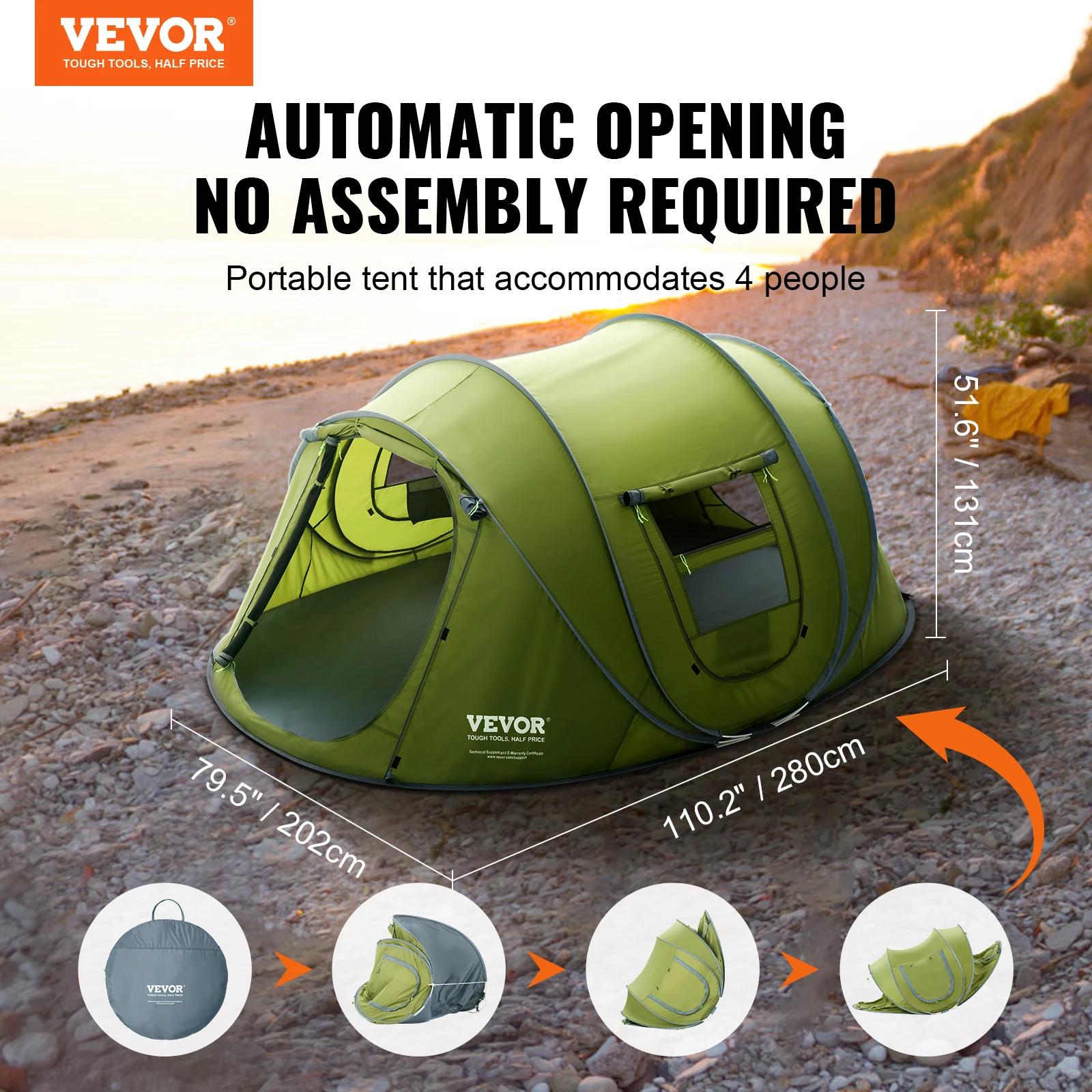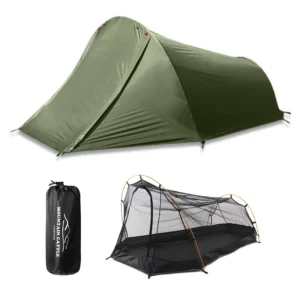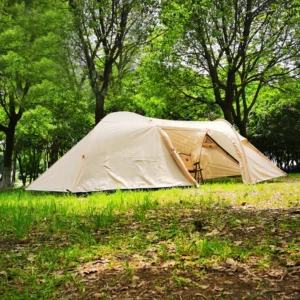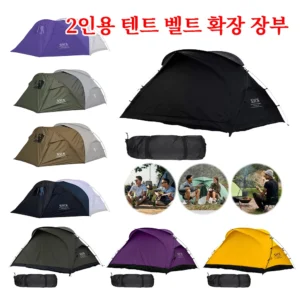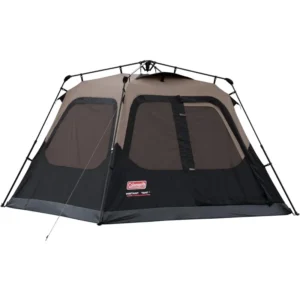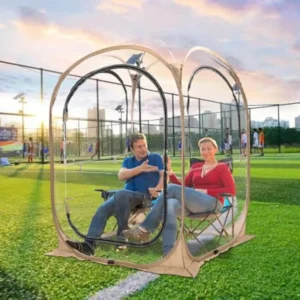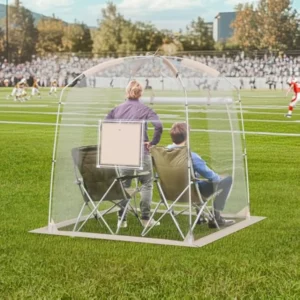Understanding the Importance of Tent Ventilation
When planning a camping trip, most people focus on finding a tent that’s waterproof, durable, and the right size. However, one crucial feature often gets overlooked until it’s too late: proper ventilation. Good airflow in your dome tent isn’t just a luxury—it’s essential for a comfortable and enjoyable camping experience.
Ventilation matters because of simple science. As you sleep and breathe inside your tent, your body releases warm, moist air. When this warm air meets the cooler surface of your tent walls, condensation forms—much like fog on a bathroom mirror after a hot shower. The average person releases approximately 1 pint (0.5 liters) of moisture through breathing and perspiration each night. In a poorly ventilated tent, all that moisture has nowhere to go.
The problems caused by inadequate ventilation include:
- Wet sleeping bags and clothing that won’t dry properly
- Dampness that can damage electronic equipment
- Musty, uncomfortable sleeping conditions
- Potential mold and mildew growth on tent materials
- Increased feelings of stuffiness and discomfort
Understanding the basic structure of dome tents for two people helps explain why proper airflow matters so much. When designed correctly, a well-ventilated tent creates a more pleasant environment by regulating temperature and humidity levels, keeping you cooler in warm weather and reducing dampness in all conditions.
The temperature difference between your body heat inside and the cool night air outside creates the perfect conditions for condensation. However, with strategic snow tent ventilation and condensation control, this natural process can be managed effectively, ensuring that moisture escapes rather than accumulating on your gear.
Anatomy of a Well-Ventilated Dome Tent
Understanding the components that make up a well-ventilated dome tent will help you make an informed purchase decision. Let’s explore the key elements that work together to create optimal airflow.
Mesh Panels: The Lungs of Your Tent
The most visible ventilation feature in quality dome tents is mesh paneling. These panels are typically made from no-see-um mesh (containing 20-50 holes per square inch) that keeps insects out while allowing air to flow freely. The best ventilated tents feature strategic mesh placement—on the upper dome, doors, and windows—creating multiple pathways for air circulation.
Strategic Vent Positioning
The position of vents is as important as their presence. Well-designed dome tent structures incorporate both high and low vents to create what’s known as the “chimney effect”:
- Low vents: Located near the ground to draw in cooler air
- High vents: Positioned at the top of the tent to release warm air that naturally rises
- Cross-ventilation: Vents positioned on opposite sides to create airflow paths
This strategic placement creates continuous circulation, with warm air rising and exiting through upper vents while fresh air enters through lower openings.
Rainfly Design and Clearance
The rainfly—the waterproof layer that covers your tent—plays a crucial role in ventilation. Superior designs feature:
- Adequate clearance between the rainfly and tent body (ideally 3-5 inches/7.6-12.7 cm)
- Adjustable configurations that allow partial coverage in fair weather
- Integrated vents that remain functional even during rainfall
The space between your tent body and rainfly creates an insulating air channel that assists with moisture management and temperature regulation.
Door and Vestibule Configuration
Multiple doors do more than provide convenient entry and exit—they’re essential ventilation points. The best ventilated dome tents feature door designs that:
- Can be partially or fully opened for airflow
- Include mesh panels that allow ventilation even when the door fabric is zipped closed
- Work with vestibule designs that funnel fresh air into the tent
When these components work together as an integrated system, the result is a comfortable interior environment regardless of outside conditions.
7 Key Ventilation Features to Look For When Choosing a Dome Tent
When shopping for a dome tent with superior ventilation, certain features will significantly impact your comfort. Here are the seven most important ventilation elements to consider:
Multiple Mesh Panels
Look for tents with substantial mesh coverage—ideally 30-50% of the tent body. These panels should be strategically placed on doors, windows, and the upper portion of the tent to maximize airflow while maintaining structural integrity. The dome tent shapes and stability shouldn’t be compromised by these ventilation features.Adjustable Rainfly Configurations
A versatile rainfly system allows you to adapt to changing conditions. The best options include:
* Partial coverage settings for warm, clear nights
* Multiple tie-back options to expose mesh sections
* The ability to pitch the rainfly higher in dry, hot weatherHigh and Low Vent Positioning
Effective tents feature vents at different heights to create natural air circulation. This design encourages warm air to rise and exit through upper vents while drawing in fresh air through lower openings, maintaining constant airflow even when the tent is fully closed.Double-Wall Construction with Proper Spacing
The gap between your tent’s inner wall and rainfly creates an essential thermal buffer zone. Quality tents maintain 3-5 inches (7.6-12.7 cm) of separation between these layers, allowing moisture to escape rather than condensing on interior surfaces.Multiple Door Designs
Two or more doors positioned on different sides of the tent allow for maximum cross-ventilation. These should feature mesh options that maintain airflow even when closed against insects or light rain.Kickstand Vents
These clever design features use rigid supports to hold rainfly vents open even during rainfall. They create protected openings that allow air exchange while keeping precipitation out, a crucial feature for maintaining ventilation in wet weather.Breathable Yet Waterproof Materials
Modern tent fabrics balance water resistance with breathability. Look for ripstop nylon with appropriate coatings that repel water while allowing microscopic water vapor molecules to escape.
These features are especially important when selecting a dome camping tent for extended outdoor stays. Remember that the best ventilation system combines multiple features working together rather than relying on a single solution.
Top 5 Dome Tents with Exceptional Ventilation
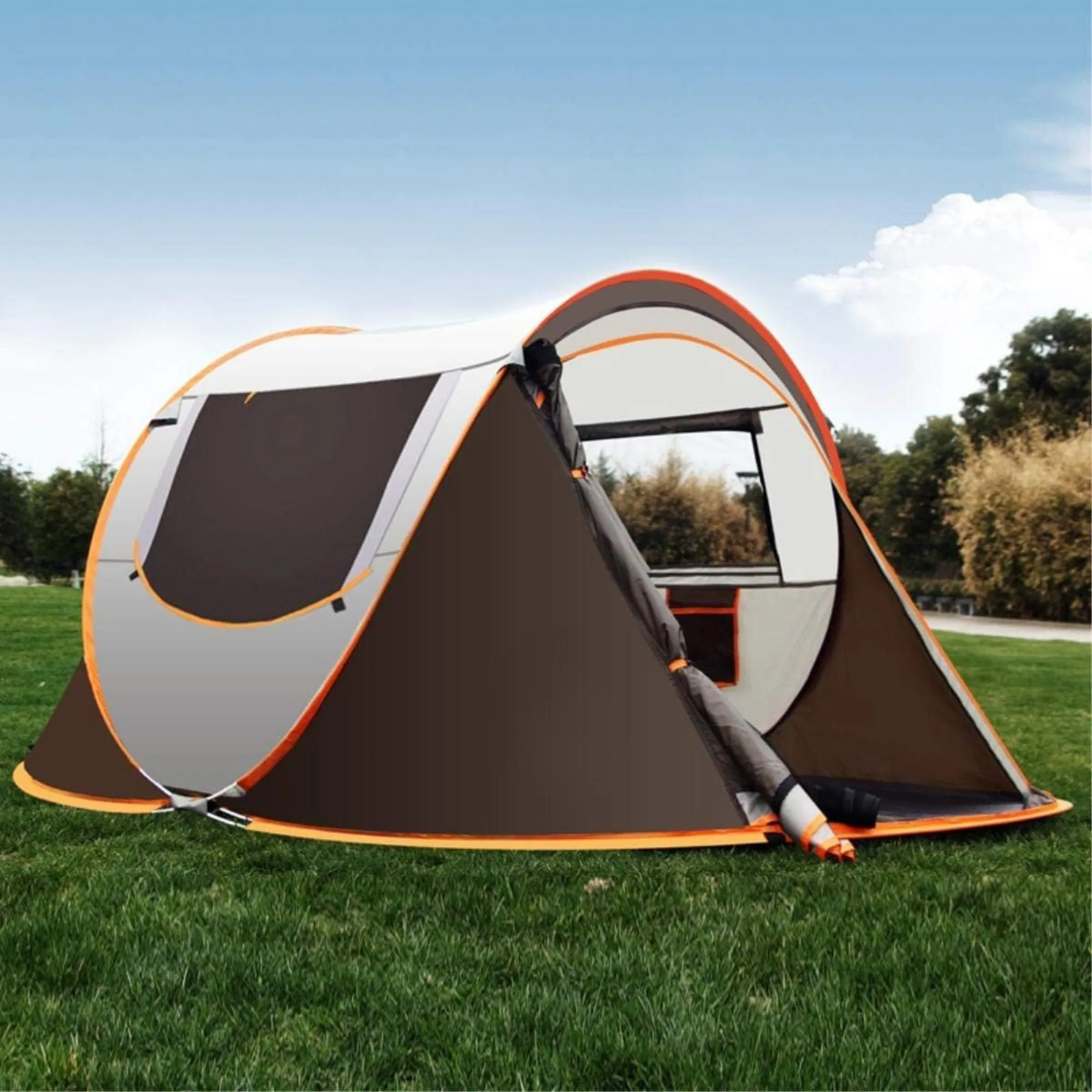
After thorough testing and evaluation, we’ve identified five dome tents that excel in ventilation performance. Each balances airflow with other important features to create comfortable camping environments in various conditions.
1. The Mountain Breeze Pro
Overview: This premium 3-season dome tent combines excellent ventilation with rugged durability, making it ideal for varied conditions.
Ventilation Features:
* 40% mesh body construction with no-see-um netting
* Four oversized kickstand vents that remain functional in rainfall
* Dual vestibules with adjustable openings
* High/low vent system creating excellent chimney effect
Capacity & Weight: 2-person capacity, lightweight category
Price Range: Premium
Best For: Hot weather camping and humid environments
Pros: Exceptional airflow even with rainfly attached; adjustable ventilation options for different conditions; minimal condensation even in challenging environments
Cons: Premium price point; mesh coverage reduces insulation in cold conditions
2. CrossFlow Expedition Dome
Overview: A mid-range option that focuses on cross-ventilation through innovative door and window placement.
Ventilation Features:
* Opposing door design for maximum cross-breeze
* Six adjustable side vents with waterproof awnings
* Partial rainfly configuration options for warm nights
* Mesh roof panels with rainfly vents directly above
Capacity & Weight: 3-person capacity, standard weight
Price Range: Mid-range
Best For: Mixed weather conditions where adaptability matters
Pros: Excellent customization for different weather scenarios; good balance between ventilation and weather protection
Cons: More complex setup due to multiple ventilation features; heavier than ultralight options
3. AirCore Ultralight
Overview: A budget-friendly option that doesn’t compromise on airflow, perfect for backpackers prioritizing weight savings.
Ventilation Features:
* Near-vertical walls with high mesh percentage (45%)
* Integrated roof vents in lightweight rainfly
* Low-level ground vents to encourage air circulation
* Proprietary breathable floor fabric reduces moisture ingress
Capacity & Weight: 2-person capacity, ultralight category
Price Range: Mid-range
Best For: Backpacking and warm-weather camping
Pros: Impressive ventilation-to-weight ratio; packs down extremely small; performs well in hot conditions
Cons: Less durable in extreme conditions; condensation can be an issue in heavy rain
4. FourSeason Ventilator
Overview: A rare find that combines serious weather protection with excellent ventilation for year-round comfort.
Ventilation Features:
* Protected exhaust vents at tent apex
* Adjustable door panels with multiple configuration options
* Double-layer rainfly with ventilation channels
* Ground-level mesh panels with waterproof covers
Capacity & Weight: 4-person capacity, standard weight
Price Range: Premium
Best For: Year-round camping in varied conditions
Pros: Maintains good airflow even in winter setups; handles condensation exceptionally well in cold conditions
Cons: Heavier design; requires proper setup to maximize ventilation benefits
5. Weekend Explorer
Overview: A budget-friendly family dome tent with thoughtful ventilation features for casual campers.
Ventilation Features:
* Large mesh windows on all sides
* Oversized dual doors with multiple configuration options
* Elevated rainfly with extended coverage
* Built-in floor vents to reduce condensation
Capacity & Weight: 4-person capacity, standard weight
Price Range: Budget
Best For: Weekend family camping in mild conditions
Pros: Excellent value; creates comfortable interior environment in most conditions; simple setup
Cons: Less effective in extreme weather; ventilation decreases with multiple occupants
These waterproof camping tents all provide excellent ventilation while serving different camping needs and budgets.
Comparison Table: Ventilation Features at a Glance
| Tent Model | Capacity | Mesh Panels | Vents | Door Config | Rainfly Adjustability | Weight Category | Price Category | Season Rating | Ventilation Rating |
|---|---|---|---|---|---|---|---|---|---|
| Mountain Breeze Pro | 2-person | 6 | 4 | Dual doors | Highly adjustable | Lightweight | Premium | 3-season | ★★★★★ |
| CrossFlow Expedition | 3-person | 4 | 6 | Opposing doors | Multiple positions | Standard | Mid-range | 3-season | ★★★★☆ |
| AirCore Ultralight | 2-person | 4 | 2 | Single door | Partial coverage option | Ultralight | Mid-range | 3-season | ★★★★☆ |
| FourSeason Ventilator | 4-person | 4 | 4 | Dual doors | Minimal adjustment | Standard | Premium | 4-season | ★★★★☆ |
| Weekend Explorer | 4-person | 6 | 2 | Dual doors | Basic adjustment | Standard | Budget | 3-season | ★★★☆☆ |
Ventilation Performance in Different Weather Conditions
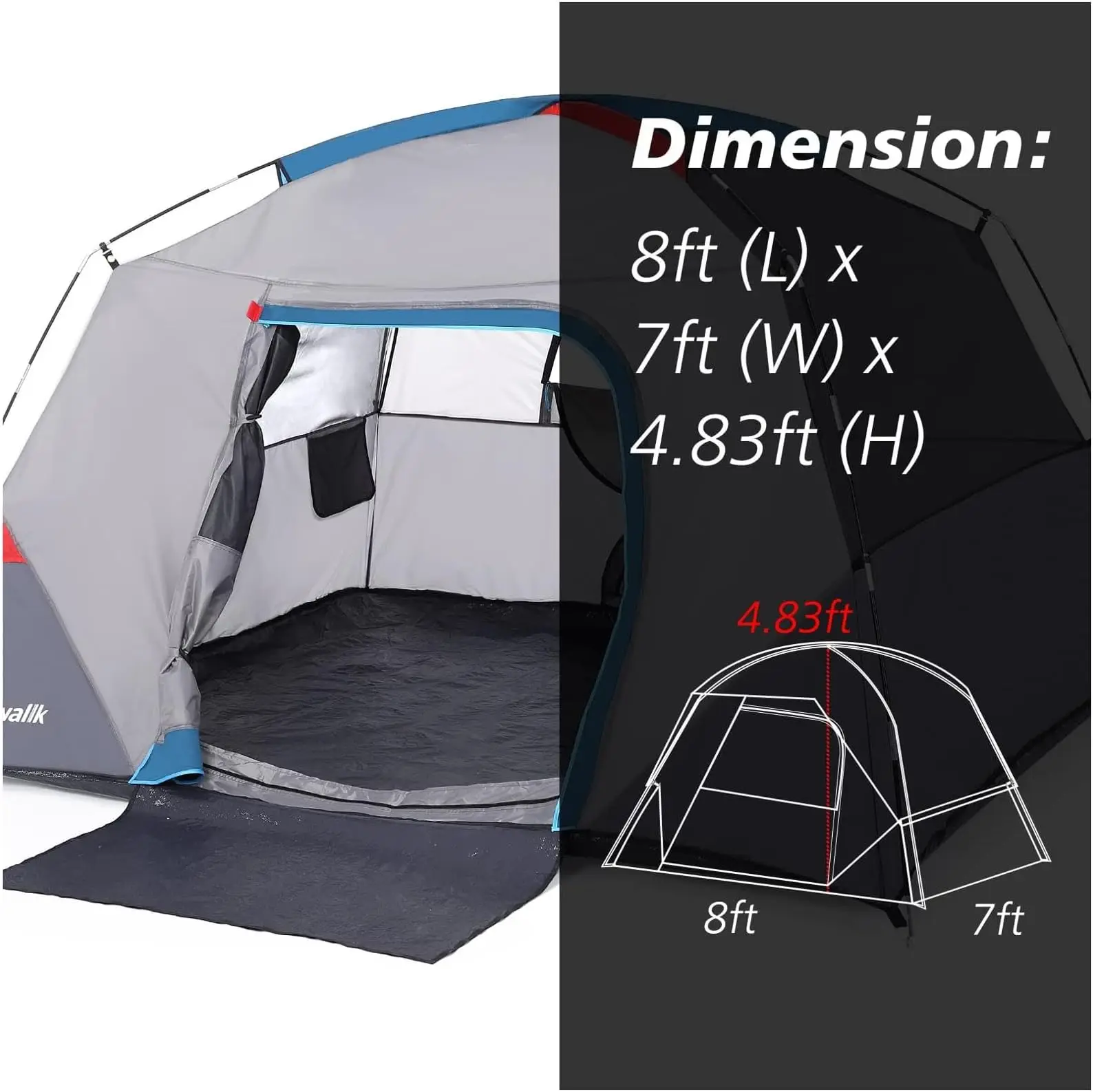
How a tent ventilates varies significantly across different conditions. Understanding these variations helps you choose the right tent and optimize its performance in varying environments.
Hot, Humid Conditions
In temperatures above 70°F (21°C) and humidity levels over 60%, ventilation becomes critical. In these conditions:
* Maximum mesh exposure is ideal
* Rainfly should be configured for partial coverage when possible
* All vents should be fully open
* Door positioning becomes crucial for capturing any available breeze
The best pop-up dome tents for hot weather feature near-vertical walls that allow hot air to rise easily and escape through roof vents.
Rainy Weather
Rain presents a ventilation challenge since you need to balance airflow with keeping water out:
* Kickstand vents become essential features
* Proper rainfly tensioning prevents contact with mesh walls
* Vestibule areas should be positioned to allow some airflow while blocking rain
* Low vents help maintain circulation even with the rainfly fully deployed
With proper design, a quality tent can maintain good airflow even during extended rainfall.
Cold Environments
In cold weather, the ventilation equation changes—you need enough airflow to prevent condensation without losing too much heat:
* Smaller, strategic vents work better than large mesh panels
* Upper vents remain crucial for allowing moisture to escape
* Rainfly should be fully deployed but properly tensioned to maintain air gaps
* Ground vents help reduce condensation from the cold ground
Understanding how tent wind resistance works with ventilation becomes particularly important in cold, windy conditions.
Windy Conditions
Wind creates both challenges and opportunities for tent ventilation:
* Position the tent to use wind to your advantage
* Doors and vents facing away from strong winds prevent buffeting
* Windward vents may need to be closed while leeward vents remain open
* Proper staking and tensioning becomes crucial to maintain ventilation gaps
With thoughtful positioning, wind can actually enhance your tent’s ventilation rather than compromising it.
Expert Tips for Maximizing Tent Ventilation
Even the best-designed tent can benefit from proper setup and usage techniques. These professional tips will help you get the most from your tent’s ventilation features:
Orient your tent strategically – Position doors and vents perpendicular to prevailing breezes when possible, with doors ideally facing east/west for natural cross-ventilation using morning and evening air movements.
Perfect your rainfly tensioning – Create maximum space between the rainfly and tent body by properly staking and tensioning all attachment points. Even an extra half-inch of separation can significantly improve airflow.
Adjust throughout the day – Ventilation needs change with conditions. Open upper vents more during mid-day heat and close them partially at night when temperatures drop to maintain balance between airflow and warmth.
Create ground clearance – When setting up, roll back the tent floor slightly at corners to create small ground-level gaps that allow air entry without compromising weather protection.
Reduce interior moisture sources – Keep wet gear in vestibules rather than the main tent area, and avoid cooking inside the tent, as food preparation releases significant moisture.
Use natural terrain features – Set up on slight rises where possible, as these locations typically receive better airflow than depressions or completely flat ground.
Consider a tent fan – For extremely still conditions, a small battery-powered fan can enhance the natural ventilation features of your tent.
These techniques work with any dome tent design and can significantly improve comfort, especially in challenging conditions.
How to Test a Tent’s Ventilation Before Purchase
Finding a tent with excellent ventilation requires some detective work before you buy. Here’s how to evaluate ventilation quality during your shopping process:
In-Store Inspection
- Get inside the tent and look up—more mesh equals better potential ventilation
- Check if vents can be opened and closed from inside the tent
- Examine the space between the rainfly and tent body (should be at least 3-4 inches/7.6-10.2 cm)
- Look for adjustable features on the rainfly and doors
Specification Analysis
- Check the mesh-to-solid fabric ratio (aim for at least 30-40% mesh)
- Count the number and position of dedicated vents
- Look for “low-high” vent pairs that create vertical air circulation
- Verify that the tent has multiple door options if cross-ventilation is important
Review Interpretation
- Look for terms like “stuffiness” or “condensation” as red flags
- Pay attention to reviews mentioning performance in rain (good ventilation while keeping water out is the ultimate test)
- Note mentions of morning dampness, which suggests inadequate overnight ventilation
- Focus on reviews from environments similar to where you’ll be camping
When evaluating specifications, remember that the relationship between features matters as much as their presence—a well-integrated ventilation system outperforms a collection of uncoordinated features.
Common Ventilation Problems and Solutions
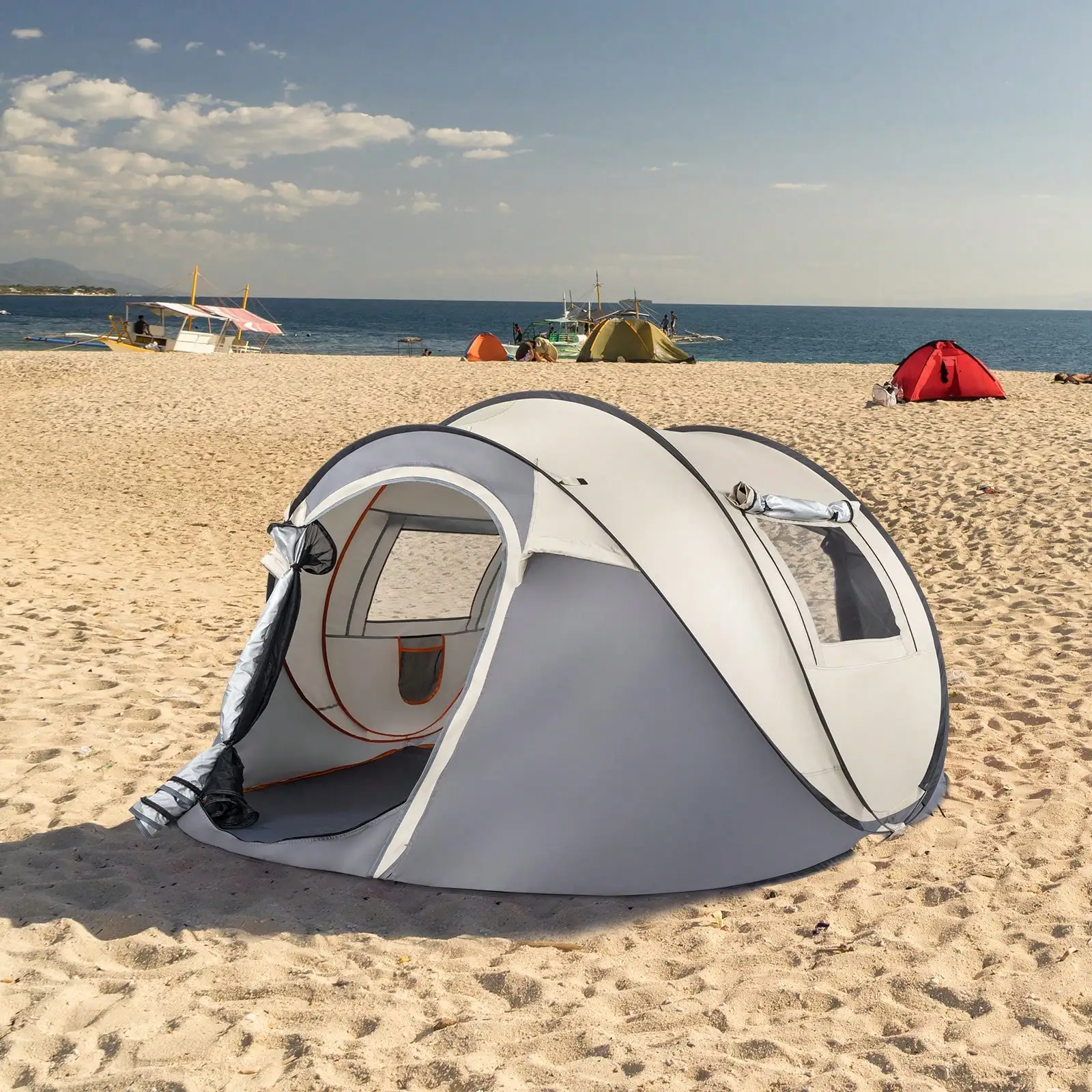
Even with a well-ventilated tent, you might encounter airflow challenges. Here are common issues and practical solutions:
Condensation Despite Ventilation Features
Problem: You wake up to wet walls despite having vents open.
Solution: Create greater temperature balance by keeping vents open on both high and low positions; wipe down tent walls in the morning; use a small camping towel to absorb excess moisture; avoid breathing directly onto tent walls.
Privacy vs. Airflow Conflicts
Problem: Maximum ventilation often means minimum privacy.
Solution: Look for easy setup camping tents with strategic mesh placement that offers ventilation above eye level; use the rainfly as a privacy shield while keeping upper vents exposed; position your tent away from high-traffic areas.
Balancing Ventilation with Insect Protection
Problem: Opening vents means inviting bugs inside.
Solution: Ensure all vent openings include fine mesh barriers; use citronella candles outside tent entrances; rely on upper vents at dawn and dusk when insects are most active; check that mesh is intact before each trip.
Managing Ventilation in Changing Weather
Problem: Conditions can shift rapidly from requiring maximum ventilation to needing weather protection.
Solution: Practice quick rainfly adjustments before your trip; keep guy lines attached even when the rainfly is rolled back for faster deployment; set up with weather changes in mind.
Compact Backpacking Tent, Lightweight Backpacking Tent, Waterproof Camping Tent
$335.52 Select options This product has multiple variants. The options may be chosen on the product pageCamping Tent with Vestibule, Waterproof Camping Tent
Price range: $407.89 through $479.48 Select options This product has multiple variants. The options may be chosen on the product pageBackpacking Tent with Vestibule, Trekking Pole Backpacking Tent, Waterproof Camping Tent
Price range: $271.99 through $519.52 Select options This product has multiple variants. The options may be chosen on the product pageEasy Setup Camping Tent, Instant Camping Tent
Instant Cabin Tent Double Layer Canvas 1-Minute Setup Spacious Family Camping Shelter with Air Vents$308.10 Select options This product has multiple variants. The options may be chosen on the product page
These practical solutions come from real-world experience and can enhance comfort even in challenging conditions. Remember that even the most waterproof pop-up tents require proper ventilation management to perform at their best.
FAQ: Your Tent Ventilation Questions Answered
Can I improve ventilation in my current tent?
Yes! You can enhance airflow in most tents by proper positioning (facing prevailing winds), using all available vents, creating maximum tension in the rainfly to increase the air gap, adding small battery-powered fans, and keeping doors partially open when weather permits. Some campers also add small aftermarket vents to their rainfly, though this requires careful waterproofing afterward.
Does condensation always indicate poor tent ventilation?
Not necessarily. Some condensation is almost unavoidable in certain conditions, particularly when there’s a significant temperature difference between inside and outside the tent. However, excessive condensation where water drips from the ceiling or saturates gear typically indicates ventilation problems that need addressing.
Are more expensive tents always better ventilated?
While premium tents often feature more sophisticated ventilation systems, price doesn’t guarantee better airflow. Some mid-range tents excel in ventilation through thoughtful design rather than expensive materials. Focus on specific ventilation features rather than price point when making your selection.
How does tent color affect ventilation needs?
Darker-colored tents absorb more heat from sunlight, increasing interior temperatures and creating greater need for ventilation. Light-colored tents reflect more solar radiation, resulting in cooler interiors and potentially reducing ventilation requirements during daylight hours. However, color has no effect on nighttime condensation issues.
Is a single-wall or double-wall tent better for ventilation?
Double-wall tents generally offer superior ventilation because they create an air gap between the inner tent and rainfly. This design allows moisture to escape the living space and condense on the rainfly rather than dripping back inside. Single-wall tents can be well-ventilated but typically require more strategic vent placement to achieve similar results.
Should I ventilate my tent differently in summer versus fall camping?
Absolutely. Summer camping often requires maximum ventilation to manage heat, so use all available mesh panels and position for cross-breezes. In fall, you’ll want to balance ventilation with heat retention—focus on keeping upper vents partially open to release moisture while limiting lower ventilation points to retain warmth.
Conclusion: Breathe Easy on Your Next Camping Adventure
A well-ventilated dome tent transforms your camping experience from potentially damp and uncomfortable to refreshing and enjoyable. By understanding the science behind condensation and the features that combat it, you’re now equipped to select a tent that will keep you comfortable in various conditions.
Remember that proper ventilation isn’t just about comfort—it also protects your gear from moisture damage and extends the life of your tent by reducing mold and mildew risks. The best dome tents balance excellent airflow with weather protection, creating a comfortable microclimate regardless of outdoor conditions.
When selecting your next tent, focus on the ventilation features we’ve discussed while considering your typical camping environment and personal preferences. Whether you’re weekend camping or embarking on extended adventures, proper ventilation will significantly enhance your outdoor experience.
At Explore Elements, we believe that the right gear removes barriers between you and the natural world. A properly ventilated dome tent embodies this philosophy by creating a comfortable shelter that connects you to the outdoors rather than isolating you from it.

